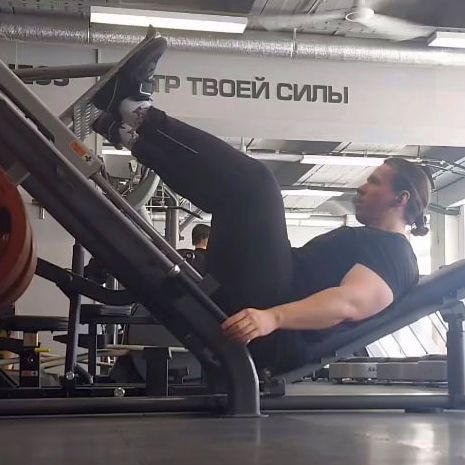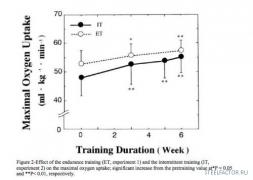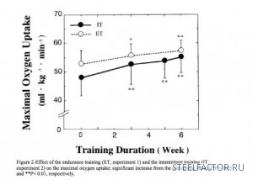Рекомендуем Вам зарегистрироваться, чтобы получить полный доступ к форуму. После регистрации Вам будет разрешено создавать топики, писать сообщения, загружать и просматривать фотографии, оценивать посты других форумчан, управлять собственным профилем на форуме и многое другое. Личные сообщения доступны после 50 оставленных на форуме сообщений . Полный доступ к разделу "Химия" так же доступен после 50 сообщений. Если у Вас уже есть аккаунт, войдите здесь, либо зарегистрируйтесь!

Протокол ТАБАТА (TABATA) + ЛИТВИ-СПРИНТ (LitviSprints)
#32

 Отправлено 21 октября 2011 - 12:25
Отправлено 21 октября 2011 - 12:25

Я, к моему сожалению, не знаю иврита... От того не могу для вас перевести свой русский на понятный вам язык.
Эмраер написал 5-10 км, отсюда в том же порядке написано мною 30-60 минут... Как написать еще понятнее?
Я не писал о 10 км за 30 минут, я не эфиопский стайер.
Скорость 10 км/час - это скорость бега доступная моему возрасту и уровню желания двигаться...)))
Сообщение изменено: Александр Черепанов (21 октября 2011 - 12:26)
#35

 Отправлено 21 октября 2011 - 07:58
Отправлено 21 октября 2011 - 07:58

Сразу же оговорюсь - я не считаю себя специалистом по применению табаты в тренинге.
Да, много читал ранее про этот метод, сейчас пробую на себе. Выводы о его эффективности или же наоборот пока делать не буду. Кроме того мом выводы, какими бы они не были, - это всего лишь мои выводы.
Для себя я понял из всего ранее проштудированного информационного ручейка "табата": использование упражнений по максимуму включающих тело в работу, брать отягощение с которым можно выполнить довольно таки технично порядка 12 повторов и вперед...
Мне было бы интересно узнать еще чье бы то ни было мнение. Но мнение основанное на практическом применении (по возможности подкрепленное видеорядом). Сейчас же происходит "КАК ВСЕГДА": кучка критиков, которые слышали, читали и т.д.
Ты единственный пока написал, что попробовал. И о смене своих впечатлений и эмоций в течении каких то 4 минут и 8 подходов.
По упражнениям, я для себя сделал вывод, что любое движение, которое выходит за рамки 12 повторов в течении 20 секунд для ТАБАТЫ не подходит. Это скорее уже интерпретация "интервального тренинга".
#36

 Отправлено 21 октября 2011 - 09:42
Отправлено 21 октября 2011 - 09:42

Ну, я использую регулярно. Мнение сугубо положительное.Мне было бы интересно узнать еще чье бы то ни было мнение. Но мнение основанное на практическом применении (по возможности подкрепленное видеорядом). Сейчас же происходит "КАК ВСЕГДА": кучка критиков, которые слышали, читали и т.д.
Недавно имел наглядный пример разницы между двумя людьми. Использовалась тренировка из КФ, представляющая из себя 8 раундов табаты с кувалдой, потом минута отдыха, 8 раундов табаты бурпи, минута отдыха и снова 8 раундов табаты с кувалдой. Я прошел нормально, но как всегда, такая тренировка выжимает по полной. Потом то же самое решил повторить мой друг. Кувалдой в одном раунде 50 ударов пробивает без проблем, может после этого сразу сделать спринт в горку, т.е. в целом уровень подготовки не нулевой. А вот на табате кувалде не смог продолжать после 6 интервала, до которого дотянул только на характере, количество ударов упало с 12 в первом отрезке до 4 в пятом. Он был сильно удивлен результатом, потому что вроде как 50 ударов для него посильно, а тут всего около 10 в отрезке... Собрался практиковать в дальнейшем и скачал у меня МР3 трек для табаты
#38

 Отправлено 21 октября 2011 - 10:48
Отправлено 21 октября 2011 - 10:48

Извините что влезаю, но могу посоветовать выброс с гантелями. Работает все тело. Дыхалке было нормально (хотя она у меня никакая), а вот ноги "зажгло" как надо. Правда я брал легкие гантели поэтому получалось раз по 15 за раунд (что как тут написал не совсем правильно).Саша, а какие еще упражнения можно делать ?
#39

 Отправлено 21 октября 2011 - 11:15
Отправлено 21 октября 2011 - 11:15

За что извиняться? Я только "ЗА" за любой конструктивный в теме. Это куда полезнее, чем досужие разговоры ни о чем.
Я никогда не стеснялся сказать что я не знаю чего то, не стеснялся признавать свои ошибки (если аргументы оппонента поддтверждали его слова). И никогда не пишу что я истина в последней инстанции.
#41

 Отправлено 21 октября 2011 - 11:42
Отправлено 21 октября 2011 - 11:42

Леня, порой в Инете книжку "Viking Warrior Conditioning". Ето не табата, но интервальная работа, с гирей и для широкого спектра выносливости (целая система) - имхо подойдет тебе больше. если жаба точит покупать бумажную, я могу порыть и сбросить пдф.
#42

 Отправлено 21 октября 2011 - 12:18
Отправлено 21 октября 2011 - 12:18

Я думаю что выбьет... И выбьет не хило...
В вышеозвученных выписках из Интернета было написано, что не годится метод для неподготовленного человека, хоть и спортсмена.
Если все сделать правильно: выбрать должное упражнение и вес используемого снаряда, то табата убивает напрочь. Особенно сперваначалу....
Благодаря стандартным методам и ББ, и ПЛ сердце и ССС тренируются в очень ограниченном режиме, избыточная масса тела умножается на стандартно высокое давление. В этом случае к выполнению полноценной табаты надо подходить месяца три, а то и четыре. Постепенно вводя в тренировку режимы интервальной работы.
Мнение мое, вполне возможно неправильное...
Сообщение изменено: Александр Черепанов (21 октября 2011 - 12:20)
#44

 Отправлено 21 октября 2011 - 12:47
Отправлено 21 октября 2011 - 12:47

Спасибо, гляну. Сейчас гиря - модная фишка. У нас в зале висят плакаты с упражнениями, но делать по плакатам... можно, но опасно, я ведь с гирей особо не работал. А Табата удобна по вреиюмени. 15 минут и на растяжку и на упражнение, класс.
#45

 Отправлено 21 октября 2011 - 01:06
Отправлено 21 октября 2011 - 01:06

Вес кувалды 8 с копейками кг. Количество ударов- 11-10. Первые пару раз 11, потом идет по 10. Бурпи хуже- от 7 до 5 повторов в отрезке. Общее количество очков в трех движениях на крайней тренировке- 206 (81+44+81). Каждый удар идет смена рук.pochemuchka
Какой вес кувалды? Каково количество движений в отрезке? Меняется ли от отрезка к отрезку сторона с которой наносятся удары?
И хотелось бы увидеть сие действо воочию (снимите на видео и через Ютуб выложите сюда)... Банально интересно...
Съемка? Ну, если настаиваете, если это принципиально, то могу сделать. Хотя и не хочется, честно говоря, возиться. На ютубе регистрацию пробовал несколько раз пройти, но мне из-за страны проживания не дает почему-то. Плюс надо решить вопрос- на что снимать? Телефон у меня позволяет снимать только короткие ролики, потом выключается. Значит, надо или другой телефон или фотоаппарат какой-то.
#46

 Отправлено 21 октября 2011 - 01:20
Отправлено 21 октября 2011 - 01:20

Никто не настаивает и ни к чему не принуждает, само собой... Просто слова остаются словами. Кстати, это не от недоверия, делаешь ты или нет. Просто любопытно мне посмотреть, осознать что я не один такой сумашедший...)))
На Ютубе свет клином не сошелся. Есть и Рутуб, и Майл.ру, которые точно так же можно в тему прямо роликом вставить...
#48

 Отправлено 21 октября 2011 - 01:40
Отправлено 21 октября 2011 - 01:40

да в принципе кроме определенного технического геморроя с созданием ролика проблем нет. Могу в воскресенье повторить такую тренировку. Эти тренировки мы проводим вечером в степи после рабочего дня, а световой день короткий уже. Так что единственная возможность снять при дневном освещении- это сделать в выходной пораньше.Никто не настаивает и ни к чему не принуждает, само собой... Просто слова остаются словами. Кстати, это не от недоверия, делаешь ты или нет. Просто любопытно мне посмотреть, осознать что я не один такой сумашедший...)))
На Ютубе свет клином не сошелся. Есть и Рутуб, и Майл.ру, которые точно так же можно в тему прямо роликом вставить...
З.Ы. все же видится мне тут некоторый элемент развода на "слабо"
#51

 Отправлено 21 октября 2011 - 02:03
Отправлено 21 октября 2011 - 02:03

http://www.appbrain....da.android.hiit
Бесплатная програмка. Свистит когда надо
#53

 Отправлено 21 октября 2011 - 02:22
Отправлено 21 октября 2011 - 02:22

Если человек не в состоянии пробежать, ну скажем, хотя бы 3000м, это говорит, ИМХО, о крайне плохом состоянии ССС. Я имею в виду не на норматив, а просто пробежать. Лично знаю таких парней. Они работают с весами за 300кг в приседе и тяге, но не в состоянии пробежать даже не 3000, а 1000м, да и при обычной ходьбе сильно гипертрофированные ноги создают проблемы. Результат специализации, возведенной в абсолют. Я не собираюсь разводить офф-топ холивар на тему оправданности. Это личное дело каждого. Но мне как-то ближе идея неспециализированной разносторонней общефизической подготовки, если речь идет не о представителе какого-то вида спорта, а о простом физкультурнике типа меня. Чтобы и штангу какую-никакую поднять был в состоянии, и кросс пробежать, и проплыть пару километров без проблем, и пола ладошками достать... Ни в одном виде рекордов не ставишь, да и фиг с ними, зато чувствуешь себя хорошо, а если глянуть на основную массу сверстников, то вообще замечательнотоварищи, да вы просто монстры! Ещё и "легко". Чтобы столько хоть как-нибудь пробежать, нужно приличное время специально прозаниматься бегом (ну или весить 60 кг).
А пробежка на 10км, если мы говорим просто дистанции без норматива, для более-менее тренированного человека проверка скорее не физухи, а психики. По крайней мере, у меня. Уже после километра внутри начинает точить червячок сомнения "а может, ну его нафиг? Че-то сегодня жарко/холодно/сыро/грязно/кажется колено побаливает. Может, на завтра передвинуть?". Но потом бежишь третий, четвертый километр и пробегаешь все 10 и думаешь "и чего ныл-то? Нормально все". Это не очень тяжело физически, просто задалбывает монотонный бег 45 минут
#55

 Отправлено 21 октября 2011 - 03:19
Отправлено 21 октября 2011 - 03:19

Считай это диктатурой... От того что твое сообщение было банально ни о чем...
Не ты первый. Сообщения типа : табата - это фишка кроссфита. А почему ИМЕННО и ТОЛЬКО кроссфита? Да, там используется этот тренировочный метод как составляющая тренировочного процесса. И только то...
Я не занимаюсь кроссфитом , и не потому что это плохо или хорошо. КФ - это сформировавшаяся вид спорта. Со всеми плюсами и минусами профессионального спорта (как то борьба за рекорды любой ценой).
И если я, к примеру, не занимаюсь КФ, то я не могу использовать табату? Или же если я использую табату, то я занимаюсь кроссфитом?
Не все, кто поднимают штангу штангисты...
Или пиши по делу, или лучше не трать время. Ни свое, ни мое...
Железякин
Берешь ссылку на ролик из адресной строки и просто ее копируешь в сообщение. Автоматически появляется в сообщении картинка из Ютуба.
Сообщение изменено: Александр Черепанов (21 октября 2011 - 06:24)
#57

 Отправлено 21 октября 2011 - 07:21
Отправлено 21 октября 2011 - 07:21

Interval training is high intensity work, interspersed with short intervals of rest. The main idea: rest intervals allow more work to be completed at a higher level of intensity than can be accomplished with steady state training.
The modern history of interval training developed to improve running performance (See Lance Smith’s overview – Running Through History or Steve Magness’s Learning From the Past: Training Through the Ages). 20th century runners and their coaches get the credit for developing this training method. Around 1910, the Finn Paavo Nurmi and his coach Lauri Pikhala put together an interval system of training. Also, the Finnish gold medalist (5k, 10k, 8k, and cross-country) Hannes Kolehmainen prepared for his Olympic performances with interval training. These runners focused on alternating fast and slow runs. In some cases they would ramp up the effort, while decreasing the distance. For example, a 4 to 7k run, with fast speed over the last 1 to 2k, immediately followed by four to five sprints. Or, they would start with a set of sprints, followed by a longer distance run (e.g. 3km) at 75-90% of max effort.
By the mid-1930′s, the Swedish coach Gosta Holmer developed a different style of interval training. His style of training called for the athlete to vary the speed based on how they felt. So, during a long run, an athlete may alternate between a fast and a slow pace or between a fast and a medium pace or between a medium and a slow pace. The Swedish word for this type of training is Fartlek or speed play. Fartlek continues to be a very popular form of training for runners.
German coach Woldemar Gerschler, watched the Finns and Swedes and determined that there was an opportunity to include more speed work. With Gerschler interval training reached its modern definition. His system focused on greater intesity of effort, because the periods of rest or light running that followed allowed for partial recovery, prior to the next hard effort.
Interval training faded somewhat during World War II, but re-emerged with Emil Zatopek. Zatopek was an innovative athlete, willing to experiment and vary his training methods. For example, he would run in heavy army boots (they added resistance, were cheap, and lasted well on the rugged trails that he preferred to train on). When he heard that other athletes were lifting weights to gain strength, he experimented with running with his wife on his back. And, he ran intervals. Zatopek would break longer runs into shorter bursts, so that his overall average pace was faster. Zatopek took interval training to previously unheard of levels of intensity and volume.
After Zatopek, the next big breakthrough for runners came from Percy Cerutty in Australia and Arthur Lydiard in New Zealand. Cerutty was known to dislike interval training and his Stotan (stoic/Spartan)training philosophy added resistance training to running. His runners often ran on beaches and up dunes. Lydiard developed the now essential tool of periodization and insisted on high volumes of running by his athletes.
Intervals continued to play a role in training runners, but interval training was only one part of a periodized program that included a high volume of training (with long intervals), dune running, weight training, and simulating race conditions. This training program could be laid out over a set period of time with the goal of preparing an athlete for peak performance at a scheduled key event. Advances in running continued to come, but they were driven by tweaking periodization, training at altitude, introducing plyometric exercises, and understanding lactic acid build-up and VO2 max.
Other athletes, particularly those engaged in multi-sprint sports (soccer, football, basketball, hockey, tennis, and swimming) continue to use interval training, as a key technique for improving cardio-vascular endurance. Intervals have proven to be a better method of training these athletes, because long distance training at 70-80% of maximum heart rate can be detrimental to strength and power. Variations in the duration and intensity of the work period and the duration of rest periods can be tailored to meet the needs of the particular sport.
Experiments with these variables continued and in 1996, Izumi Tabata of the National Institute of Fitness and Sports in Kanoya, Japan published the results of his study on the effects of High Intensity Interval Training. Tabata designed a scientific study of a protocol that was being used by Japanese speed skaters. He compared two groups of athletes over a six week period. The first group engaged in one hour of moderate intensity (70% of VO2 max) steady state endurance training on a stationary bicycle. These athletes trained five days per week.
The second group followed a protocol similar to the one being used by Japanese speed skaters. This group did their work on a stationary bicycle too. After a 10 minute warm up, they engaged in a 4 minute period of 8 intervals with a 2:1 ratio between work and rest. It may help to think of this as 8 sets of 20 seconds of work followed by 10 seconds of rest. During the work phase, intensity was kept high at 270% of VO2 max with pedalling speeds at 90 rpm. If pedalling speed dropped below 85 rpm, the set was ended. If an athlete could complete nine sets at 90 rpm, then the resistance was increased to require 11 watts of additional work during the work sessions. Interval training was followed by a cool down period. One day a week the protocol was changed to allow for 30m of moderate intensity (70% of VO2 max) steady state training, followed by 4 rounds of 20s of high intensity work followed by 10s of rest.
As you can see, the Tabata protocol did not exceed the results of the steady state group for VO2 max. However, the Tabata group made substantial gains in VO2 max, particularly during the first half of the experiment. Also, the experiment started with a significant gap in VO2 max between the two groups and over the six weeks, the Tabata group was able to narrow the gap significantly.
The other significant finding is that the Tabata method of training resulted in improvements to anaerobic capacity. Whereas, the steady state training did not improve anaerobic capacity. This makes sense, given that the Tabata group was training for short periods of time at levels that exceeded their aerobic capacity.
Key findings of this study: (1) athletes can achieve good (not maximal) improvement in VO2 max with High Intensity Interval Training; (2) high intensity interval training has some anaerobic benefits for athletes, that cannot be achieved with steady state aerobic exercise alone; (3) compared to the steady state group, less time was required for this type of training.
Coaches and trainers have applied the Tabata protocol to many other exercises. Porting this protocol to a rowing machine or sprints on the track or in the pool is straightforward. However, an interesting set of mutations have occurred. First, coaches and trainers began applying a Tabata inspired protocol to body-weight exercises, such as pushups, pullups, or burpees (8 rounds of 20s of intense effort, performing as many repetitions as possible, followed by 10s of rest). Then, they created circuit training routines, where each station had a different exercise and followed the Tabata inspired 8 rounds of 20s of intense effort followed by 10s of rest (e.g. Tabata This by CrossFit). Next came the incorporation of resistance training exercises, using barbells, dumbbells, and other weights (e.g. front squats and thrusters). These adaptations have become popular in recent years with the rise of CrossFit. Note, these mutations are not following the Tabata protocol, even if they are colloquially referred to as Tabata workouts.
More recently, efforts have been made to develop and study interval training that is less intense than the Tabata protocol. The goal is to retain most of the benefits, while being able to safely incorporate high intensity intervals into general fitness training. A 2009 study by Jonathan Little and Martin Gibala of the Kinesiology Department at McMaster University focused on a two week session of a less extreme form of high intensity interval training. Subjects completed 8 to 12 rounds on a stationary bike with 60 seconds of exercise at approximately 100% of VO2 max, followed by 75s of rest. The results in improved VO2 max approximated the results expected for individuals training for longer periods of time (5 hours per week) at steady state levels. This less extreme form of High Intensity Interval Training has gained traction in the popular press, as people are hoping that the protocol may allow for health benefits similar to longer periods of steady state training (improved cardio-vascular endurance and weight loss) with less time spent on the dreadmill.
As runners discovered, interval training has its limits. Intervals are not a magic formula or universal solution. Although the initial results are positive, before anointing High Intensity Interval Training as the optimum protocol for restoring fitness in the general population, issues remain:
—For individuals training on their own, intensity is not likely to be at Tabata levels and even working at the less intense levels may be a hard sell.
—Does this form of training adequately prepare muscles to perform in an endurance setting? VO2 max is only one element of endurance performance. While a Tabata trained athlete may have adequate VO2 to compete in an endurance event, it seems likely that they may be under prepared in other areas necessary for successful performance. One area of concern is whether muscle endurance is trained adequately.
—Similarly, with Tabata inspired resistance training, what sort of gains can be expected. For example, if my current maximum number of reps for pullups is 15 and I follow a Tabata inspired 8 rounds doing pullups four times per week with a fifth day doing 8 pullups and 4 Tabata inspired rounds, after 6 weeks can I anticipate that my max performance will improve to 18 or 20 repetitions?
—Where are the plateaus? As pointed out in the Body Recomposition piece, the majority of the VO2 gains come in the first three weeks of training and the majority of anaerobic gains come within the first four weeks. Will continued training result in breaking through this plateau, will further training of this sort maintain the new levels of performance, or over time will there be deterioration (burn out)?
Coaches, athletes, and scientists will continue to study and experiment with interval training. Meanwhile, interval training is a versatile conditioning method that you can incorporate into your training. How versatile…check out Indecent Intervals, by John Berardi for some inspiration.
http://seeadamtrain....erval-training/
Сообщение изменено: Александр Черепанов (21 октября 2011 - 07:24)
#58

 Отправлено 21 октября 2011 - 07:29
Отправлено 21 октября 2011 - 07:29

Title and Abstract
Tabata I. et. al. Effects of moderate-intensity endurance and high-intensity intermittent training on anaerobic capacity and VO2max. Med Sci Sports Exerc. (1996) 28(10):1327-30.
This study consists of two training experiments using a mechanically braked cycle ergometer. First, the effect of 6 wk of moderate-intensity endurance training (intensity: 70% of maximal oxygen uptake (VO2max), 60 min.d-1, 5 d.wk-1) on the anaerobic capacity (the maximal accumulated oxygen deficit) and VO2max was evaluated. After the training, the anaerobic capacity did not increase significantly (P > 0.10), while VO2max increased from 53 +/- 5 ml.kg-1 min-1 to 58 +/- 3 ml.kg-1.min-1 (P < 0.01) (mean +/- SD). Second, to quantify the effect of high-intensity intermittent training on energy release, seven subjects performed an intermittent training exercise 5 d.wk-1 for 6 wk. The exhaustive intermittent training consisted of seven to eight sets of 20-s exercise at an intensity of about 170% of VO2max with a 10-s rest between each bout. After the training period, VO2max increased by 7 ml.kg-1.min-1, while the anaerobic capacity increased by 28%. In conclusion, this study showed that moderate-intensity aerobic training that improves the maximal aerobic power does not change anaerobic capacity and that adequate high-intensity intermittent training may improve both anaerobic and aerobic energy supplying systems significantly, probably through imposing intensive stimuli on both systems.
Background
In recent years, training and the Internets have become interval crazy. Everybody wants to do nothing but interval training all the damn time (with some even proclaiming that any non-interval training is not only useless but downright detrimental).
Now, I’ve written extensively about this in what must be about a 12 part series on Steady State vs. Interval Training here on the site. I’m not going to rehash the entirety of that series, mind you; go read it. But simply, both intervals and steady state have their place in training. Arguments that one is inherently or always superior to the other has more to do with marketing than reality.
But among other aspects of this particular meme, the idea of the Tabata protocol (often abbreviated Tabatas) gets bandied about all the time. And the problem is that people are using the term to describe something that they don’t really understand. What has happened is that a bunch of people who don’t really know what they are talking about have written so much about the protocol that what it actually is or accomplishes has been completely diluted.
So I figured I’d undilute it by actually examining the study that the whole set of claims and supposed ‘protocols’ are based on. Because, as is so often the case, what people think they are doing as ‘Tabatas’ are nothing like what the actual study did. And most people who think they are doing the Tabata protocol are doing absolutely nothing of the sort.
As a bit of history, the protocol was actually originally developed by a Japanese speed skating coach and later studied by researchers; I bring this up because speed skating is actually a very peculiar sport in a lot of ways (something that I have insight into as I’ve spent the last 5 years training full time as a skater). But I’m not going to get that into detail here; I simply mention it for completeness.
The Study
The study set out to compare both the anaerobic and aerobic adaptations (in terms of one parameter only, VO2 max) to two different protocols of training. The study recruited 14 active male students who were, at best moderately trained (VO2 max was roughly 50 ml/kg/min which is average at best; elite endurance athletes have values in the 70-80 range).
All work including the pre- and post tests were done on a mechanically braked bicycle ergometer; this is an important point that is often ignored and I’ll come back to in the discussion. Every test or high-intensity workout was proceeded by a 10 minute warm-up at 50% of VO2 max (This is maybe 60-65% maximum heart rate).
The two primary tests were VO2 max and the maximal accumulated oxygen deficit (this is a test of anaerobic capacity, basically people with higher anaerobic capacity can generate a larger oxygen deficit) and then subjected to one of two training programs.
The first program was a fairly standard aerobic training program, subjects exercised 5 days/week at 70% of VO2 max for 60 minutes at a cadence of 70 RPMs for 6 straight weeks. The intensity of exercise was raised as VO2 max increased with training to maintain the proper percentage. VO2 max was tested weekly in this group and the maximal accumulated oxygen deficit was measured before, at 4 weeks and after training.
The second group performed the Tabata protocol. For four days per week they performed 7-8 sets of 20 seconds at 170% of VO2 max with 10 seconds rest between bouts, again this was done after a 10 minute warm-up. When more than 9 sets could be completed, the wattage was increased by 11 watts. If the subjects could not maintain a cadence of 85RPM, the workout was ended.
On the fifth day of training, they performed 30 minutes of exercise at 70% of VO2 max followed by 4 sets of the intermittent protocol and this session was designed to NOT be exhaustive. The anaerobic capacity test was performed at the beginning, week 2, week 4 and the end of the 6 week period; VO2 max was tested at the beginning and at week 3, 5 and the end of training.
Results
For group 1, the standard aerobic training group, while there was no increase in anaerobic capacity, VO2 max increased significantly from roughly 52 to 57 ml/kg/min (I say roughly because the paper failed to provide vaules, I’m going by what’s in the graphic below). Frankly, given the lack of anaerobic contribution to steady state training, the lack of improvement in this parameter is absolutely no surprise.
For group 2, both the anaerobic capacity and VO2 max showed improvements. VO2 max improved in the interval group from 48 ml/kg/min to roughly 55 ml/kg/min (see graphic below). It is worth noting that the interval group was starting with a lower value and may have had more room for improvement. Also note that they still ended up with a lower Vo2 max than the steady state group.
I’ve put Figure 2 from the paper (showing improvements in VO2 max) below
As I noted, pay attention to the fact that the Tabata group (black line, filled circles) started lower than the steady state group, they also still ended up lower than the steady state group. As well, note that pattern of improvement, the Tabata group got most of their improvement in the first 3 weeks and far less in the second three weeks. The steady state group showed more gradual improvement across the entire 6 week period but it was more consistent. As the researchers state regarding the Tabata group
After 3 wk of training, the VO2 max had increased significantly by 5+-3ml.kg/min. It tended to increase in the last part of the training period but no significant changes [emphasis mine] were observed.
Basically, the Tabata group improved for 3 weeks and then plateaued despite a continuingly increasing workload. I’d note that anaerobic capacity did improve over the length of the study although most of the benefit came in the first 4 weeks of the study (with far less over the last 2 weeks).
My Comments
First and foremost, there’s no doubt that while the steady state group only improved VO2 max, it did not improve anaerobic capacity; this is no shock based on the training effect to be expected. And while the Tabata protocol certainly improved both, not only did the Tabata group still end up with a lower VO2 at the end of the study, they only made progress for 3 weeks before plateauing on VO2 max and 4 weeks for anaerobic capacity.
Interestingly, the running coach Arthur Lydiard made this observation half a century ago; after months of base training, he found that only 3 weeks of interval work were necessary to sharpen his athletes. More than that was neither necessary nor desirable. Other studies using cycling have found similar results: intervals improve certain parameters of athletic performance for about 3 weeks or 6 sessions and then they stop having any further benefit.
I’ve asked this question before but for all of the ‘All interval all the time’ folks, if intervals stop working after 3-4 weeks, what are people supposed to do for the other 48-49 weeks of the year. Should they keep busting their nuts with supra-maximal interval training for no meaningful results?
On that note, it’s worth mentioning that the Tabata group actually did a single steady state workout per week. Is it at all possible that this contributed to the overall training effect (given that 70% VO2 max training improved VO2 max in the steady state only group)? Does anybody else find it weird that the Tabata promoters ignore the fact that the Tabata group was doing steady state work too?
It’s also relevant to note that the study used a bike for training. This is important and here’s why: on a stationary bike, when you start to get exhausted and fall apart from fatigue, the worst that happens is that you stop pedalling. You don’t fall off, you don’t get hurt, nothing bad happens. The folks suggesting high skill movements for a ‘Tabata’ workout might want to consider that. Because when form goes bad on cleans near the end of the ‘Tabata’ workout, some really bad things can happen. Things that don’t happen on a stationary bike.
As well, I want to make a related comment: as you can see above the protocol used was VERY specific. The interval group used 170% of VO2 max for the high intensity bits and the wattage was increased by a specific amount when the workout was completed. Let me put this into real world perspective.
My VO2 max occurs somewhere between 300-330watts on my power bike, I can usually handle that for repeat sets of 3 minutes and maybe 1 all out-set of 5-8 minutes if I’m willing to really suffer. That’s how hard it is, it’s a maximal effort across that time span.
For a proper Tabata workout, 170% of that wattage would be 510 watts (for perspective, Tour De France cyclists may maintain 400 watts for an hour). This is an absolutely grueling workload. I suspect that most reading this, unless they are a trained cyclist, couldn’t turn the pedals at that wattage, that’s how much resistance there is.
If you don’t believe me, find someone with a bike with a powermeter and see how much effort it takes to generate that kind of power output. Now do it for 20 seconds. Now repeat that 8 times with a 10 second break. You might learn something about what a Tabata workout actually is.
My point is that to get the benefits of the Tabata protocol, the workload has to be that supra-maximal for it to be effective. Doing thrusters or KB swings or front squats with 65 lbs fo 20 seconds doesn’t generate nearly the workload that was used during the actual study. Nor will it generate the benefits (which I’d note again stop accruing after a mere 3 weeks). You can call them Tabatas all you want but they assuredly aren’t.
Finally, I’d note that, as I discussed in Predictors of Endurance Performance VO2 max is only one of many components of overall performance, and it’s not even the most important one. Of more relevance here, VO2 max and aerobic endurance are not at all synonymous, many people confuse the two because they don’t understand the difference between aerobic power (VO2 max) and aerobic capacity (determined primarily by enzyme activity and mitochondrial density within the muscle). Other studies have shown clearly that interval work and steady state work generate different results in this regards, intervals improve VO2 max but can actually decrease aerobic enzyme activity (citrate synthase) within skeletal muscle.
The basic point being that even if the Tabata group improved VO2 max and anaerobic capacity to a greater degree than the steady state group, those are not the only parameters of relevance for overall performance.
Summing Up
First, here’s what I’m not saying. I’m not anti-interval training, I’m not anti-high intensity training. I am anti-this stupid-assed idea that the only type of training anyone should ever do is interval training, based on people’s mis-understanding and mis-extrapolation of papers like this.
High-intensity interval training and the Tabata protocol specifically are one tool in the toolbox but anybody proclaiming that intervals can do everything that anyone ever needs to do is cracked. That’s on top of the fact that 99% of people who claim to be doing ‘Tabatas’ aren’t doing anything of the sort.
Because 8 sets of 20″ hard/10″ easy is NOT the Tabata protocol and body-weight stuff or the other stuff that is often suggested simply cannot achieve the workload of 170% VO2 max that this study used. It may be challenging and such but the Tabata protocol it ain’t.
#59

 Отправлено 21 октября 2011 - 07:33
Отправлено 21 октября 2011 - 07:33

Fat Loss in Four Minutes
by Dan John
A couple of years ago, a company came out with an exercise machine that guaranteed results in only four minutes a day. The main problem? The $12,000 price tag. My car doesn't cost that much. I'm not sure I've ever spent that much on anything, including my education.
Well, I'm going to save you a lot of money today because I'm going to show you how to do the same thing without an overpriced machine. This "top secret" training method may do more for you than all your other training combined and leave you with 23 hours and 56 minutes to live the rest of your day.
But there's a price to pay. Think exhaustion, vomit and pools of sweat.
Enter the Tabata Method
Tabata is the name of a Japanese researcher who discovered an interesting way to increase both anaerobic and aerobic pathways at the same time. It's one of those strange training programs that seems to fit across disciplines: it's excellent for bicyclists, speed skaters, Olympic lifters, or the person looking to lose fat quickly.
This training method is so simple, yet so incredibly difficult, that athletes tend to try it once, acknowledge its greatness, and then vow to never speak its name again. What is it? It's simple: take one exercise and perform it in the following manner:
1) For twenty seconds, do as many repetitions as possible.
2) Rest for ten seconds
3) Repeat seven more times!
That's it! You're done in four minutes! Oh, and that thing you're trying to brush off your face? That would be the floor.
Eight sets of "as many reps as you can get done," followed with a brief ten second rest— simple and effective. The two best exercise options for the Tabata method are the front squats and the "thruster," which I'll describe in a bit.
It helps to have someone record the reps of each set for you because, well, you won't remember after you pass out. I use the "lowest rep number" of any of the eight sets as my measurement to compare workout to workout. If you go too heavy, that number might be two. If you go too light, you might find yourself getting around 15 reps or more.
Before we talk about the exercises, let's take a moment to be perfectly clear about what we're doing. This isn't "eight sets of eight," although the goal of doing eight reps in each of the twenty second clusters is about right. Instead it's "as many reps as I can get in" during the twenty seconds, followed by ten seconds rest.
And by the way, ten seconds is not racking the bar, getting a drink, talking to the cute girl on the bike, looking at the clock, walking back to the bar, chalking up, adjusting the belt, talking to a friend, then doing the next set. Ten second is ten seconds! No cheating!
Tabata Exercises
You need to choose an exercise that uses a large number of muscles. I suggest the front squat. Now, you may argue, why not the back squat? Well, it's hard to dump the bar quickly into the rack with back squats, while with front squats, you can simply fall into it and start your ten second rest.
With something like a military press, you won't be using enough muscles to allow you to survive in the last minute; you might only get one or two reps with your shoulders on fire. Deadlifts have been tried, but most people get a little worried about injuries doing them Tabata-style.
The front squat might be the single best Tabata lift. Having said that, if you don't know how to front squat correctly, the Tabata method might teach you to lift better than a thousand coaches. In the four minutes, it's easy to get 64 to 70 reps, which teaches the nervous system better than a PowerPoint presentation.
The bar will be held in the "front" of the body, with the fingers relaxed and the bar resting on the clavicles with the elbows high. Sit down "between the legs." This actually gets easier in the third and fourth minute as you just start to "drop" back through. As you rise back up, you don't need to lock out the knees; in fact, don't even think about it. Just get up and go back down.
Weight on the bar? Let's just say this: a guy with a 465 pound front squat puked with only 95 pounds on the Tabata front squat. Generally, I urge people to go "light," like 65 to 95 pounds the first time. There are those in this world who've gone up to 155 pounds and still got "eights" in the last twenty seconds, but those are very rare people!
The other great Tabata exercise is the "thruster." The thruster is one of the greatest lifts no one has ever heard of in the gym. Take two dumbbells and hold them at shoulder height. Squat down, keeping the dumbbells on the shoulders. As you rise up, press the bells to the overhead lockout position. You can either press as you rise or use the momentum to help "kick" the bells overhead. I find that I do a little bit of both in the four minutes.
Thrusters do things to your heart rate and breathing that I honestly can't describe. Go light! A 35 pound dumbbell in each hand is a very difficult thruster workout! Check your ego at the door for the first two minutes.
Tabata Tips
You need to be able to see a wall clock with a second hand during your four minutes of fun. Stop at twenty seconds, rack the bar (if you choose the front squat), rest ten seconds, grab the bar and go again. Watching the clock seems to help with the focus.
And remember this: you really shouldn't consider doing much after the Tabata workout. Your lungs will be going like a locomotive engine. Go ahead and plan anything you like, but don't be surprised if it just doesn't happen. I keep the family dog nearby to chase the carrion birds away while I rest on the sidewalk.
The hardest thing about this workout is staying focused for four minutes. Don't let your hands leave the bar or dumbbells, if you can help it. After you put the bar in the rack during the front squat, stay right there, an inch or two back from the bar, and stare at the second hand of the clock.
If you do thrusters, put the dumbbells on a bench and watch the clock with your hands ready. This little trick of staying with the weight seems to help make those ten seconds seem like, well, not much, really! But at least you don't have to move much to get the weights again.
I do either Tabata front squats or Tabata thrusters about twice a month. I'm sure someone will comment, "If it's so good, why don't you do it every day?" Go ahead, try it and report back after the second day.
240 Seconds of Pain
Why should you do this workout? The Tabata program might be the single best "fat burning workout" that I know. It might only be four minutes, but you seem to keep sweating and breathing hard for a long, long time afterwards. Moreover, it seems to teach the body the proper method of squatting far easier than all the instruction in the world.
One other thing: Tabata truly teaches a person the mental focus needed to push past pain and reach his body comp or athletic goals. It'll save you 12,000 bucks, too!
About the Author
Dan John is the Diocesan Director of Religious Education for the Diocese of Salt Lake City and a full-time "on-line" religious studies instructor for Columbia College of Missouri. Originally from South San Francisco, Dan came to Utah to throw the discus for Utah State University and never left. He has Masters degrees in history and in religious education, as well as having done intensive work at the American University in Cairo, University of Haifa, and Cornell.
Currently, Dan is ranked number one in the world in the Highland Games, ages 45-49, broke the American record in the Weight Pentathlon last August, holds numerous National Championships in weightlifting and throwing and maintains a full-time free internet coaching site at http://danjohn.org/coach.
http://www.t-nation....e_tabata_method
0 посетителей читают эту тему
0 пользователей, 0 гостей, 0 скрытых
 Вход
Вход Регистрация
Регистрация









 Наверх
Наверх











